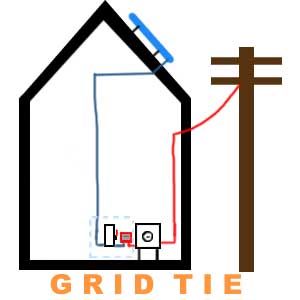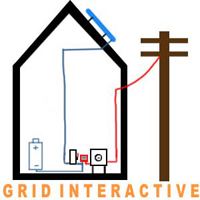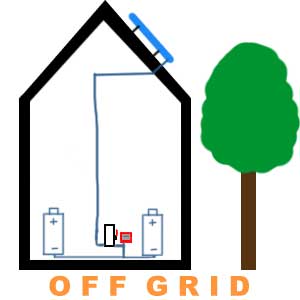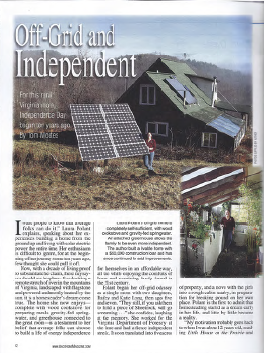Grid Tie
 This type of system, which can also be called Straight Line-Tie, requires only solar panels and a specialized inverter. This option is very popular as it is the least costly, most efficient and the “greenest.” All available energy produced flows into the house breaker-panel. If you are producing more power than you are using, the electric meters runs backward. If you are using more power than you are producing, the meter runs forward. This choice is the least expensive option since it uses the fewest components: a solar array and sine wave inverter. The system budget is then focused mainly on two components allowing a maximum number of panels and therefore maximum energy for the dollar. This type of system is the most flexible from a design standpoint as it can be scaled to displace any desired portion of your electric bill. It is important to note that this type of PV system will not produce power if the utility grid goes down — even during sunny times.
This type of system, which can also be called Straight Line-Tie, requires only solar panels and a specialized inverter. This option is very popular as it is the least costly, most efficient and the “greenest.” All available energy produced flows into the house breaker-panel. If you are producing more power than you are using, the electric meters runs backward. If you are using more power than you are producing, the meter runs forward. This choice is the least expensive option since it uses the fewest components: a solar array and sine wave inverter. The system budget is then focused mainly on two components allowing a maximum number of panels and therefore maximum energy for the dollar. This type of system is the most flexible from a design standpoint as it can be scaled to displace any desired portion of your electric bill. It is important to note that this type of PV system will not produce power if the utility grid goes down — even during sunny times.
Grid-Interactive with Battery Backup
 This option includes a solar array, a charge controller, a battery bank, and an inverter that produces utility quality AC power that can synchronize with the utility grid, or operate independent of the power company. When energized from the power company, this system keeps the battery storage at full capacity (with a combination of solar and grid power) and operates the same as a Grid-Tie system (electric meter runs forward & backward). During a power outage this type of system completely disconnects from the power company, and carries the electrical loads on its own, drawing from the battery and PV sources. Grid-Interactive systems are less efficient, cost 30% to 200% more, and are not as “green” as Grid-Tie systems
This option includes a solar array, a charge controller, a battery bank, and an inverter that produces utility quality AC power that can synchronize with the utility grid, or operate independent of the power company. When energized from the power company, this system keeps the battery storage at full capacity (with a combination of solar and grid power) and operates the same as a Grid-Tie system (electric meter runs forward & backward). During a power outage this type of system completely disconnects from the power company, and carries the electrical loads on its own, drawing from the battery and PV sources. Grid-Interactive systems are less efficient, cost 30% to 200% more, and are not as “green” as Grid-Tie systems
Off-Grid
 Stand-Alone systems are independent electrical installations that are isolated from utility company power. This requires solar panels for producing electricity, a charge controller and battery storage. An inverter is needed to convert the direct current (DC) to alternating current (AC) to allow the system to power standard appliances. Off grid systems can be very expensive, and are not “green” for typically the first 15 years of use (if ever).
Stand-Alone systems are independent electrical installations that are isolated from utility company power. This requires solar panels for producing electricity, a charge controller and battery storage. An inverter is needed to convert the direct current (DC) to alternating current (AC) to allow the system to power standard appliances. Off grid systems can be very expensive, and are not “green” for typically the first 15 years of use (if ever).
Here is an example of one off-grid system we installed that was described in Back Home Magazine (July 2010) by Tom Moates: Off-Grid and Independent: For this rural Virginia mom, Independence Day began ten years ago. (opens in a new tab)
Sizing the System
Building any renewable energy system begins with a load evaluation. Solar Connexion takes care of the technical aspect of this, based on the specifics of your personal electrical needs that you provide. The first step is to complete the online request form. You’ll be asked to provide your yearly electrical use, which allows us to determine the size of the system needed to meet your individual requirements. If you don’t have historic electric use to work from, we can help develop an expected load study.
We encourage you to examine ways to reduce your energy use as well. With a new PV system, it is a great time to consider energy efficient appliances. Energy savings on the load translates directly to cost savings in the system components if the goal is to meet energy needs with solar. For example, reduced consumption means fewer solar panels. Solar Connexion can advise on appliance selection and work with their appliance dealer network to get you the greatest savings.
System Components
Solar panels, usually multiple panels wired together and connected on a rack called an array, produce power from the sun’s rays. These must be positioned to maximum sun exposure, which means a southern exposure and avoiding shade. Even a small shadow on part of the array can greatly reduce the power production of the entire system. There are mounting options that allow the angle of the array to be adjusted according to the time of year to match the changing angle of the sun in the sky.
There is an assumption that solar panels must be mounted on a roof. This is necessary on some sites, but in reality it should be avoided when possible. Heat decreases the efficiency of PV panels, so getting maximum airflow around them helps to maximizes power production. Roofs are typically not engineered for the additional wind load caused by panels tilted at any other angle, other than the angle of the roof itself; so roof mounts typically can’t be adjusted seasonally. Roofs also require maintenance; to paint or re-shingle the roof, the panels must be removed and then re-installed.
Ground-mount solar, whether a solid pole mount array (or arrays), or a pipe rack(s) built on the ground, are the best option for ease of maintenance, repositioning, and airflow.
Inverters convert DC power to AC. Some off-grid systems eliminate the expense and additional inefficiencies of an inverter by using only DC appliances and devices made for the voltage of the battery bank in your system. For instance, if a barn requires only lighting and a water pump and the batteries are configured to 24 volts DC, specialty bulbs and a pump can be installed drawing directly from the battery bank to run off of that 24 volt DC power. Typically, however, the convenience of running standard AC power necessitates the addition of an inverter and one is always required for grid interconnectivity (Grid-Tie and Grid-Interactive).
Energy from the panels requires regulating. A charge controller takes care of this job, switching the power on and off as needed. In a straight grid-tie system, this is a function of the inverter, and is built in. If a battery bank is involved, a separate charge controller may be required.
Grid-Interactive and Off-Grid systems use deep cycle batteries. Their capacities are given in amp/hours not cold cranking amps, and are physically adapted to the needs of the long charges and discharges found in these systems. Every off-grid systems will have battery storage to carry the system through each night and days of cloudiness. Grid-Interactive systems require batteries as well. Sizing a battery bank and determining the best type for an installation requires the knowledge and experience that Solar Connexion provides. They can calculate the best options and present them to you during the planning phase.
The bulk of the what remains in a PV system is the specialty breakers, meters, lightning protection, and other small devices that go between the larger components.

